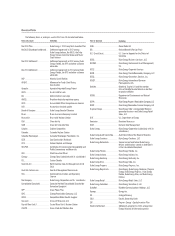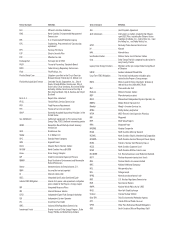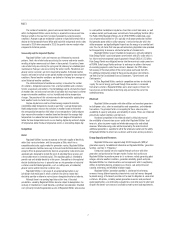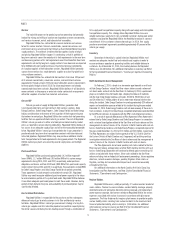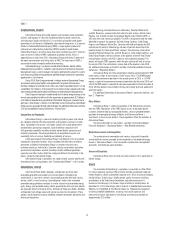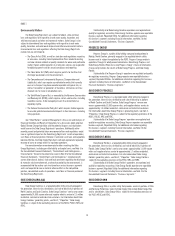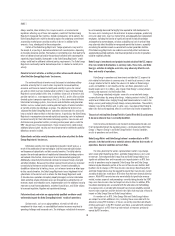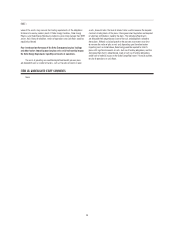Duke Energy 2014 Annual Report Download - page 31
Download and view the complete annual report
Please find page 31 of the 2014 Duke Energy annual report below. You can navigate through the pages in the report by either clicking on the pages listed below, or by using the keyword search tool below to find specific information within the annual report.
PART I
11
Regulation
State
The NCUC, PSCSC, FPSC, PUCO, IURC and KPSC (collectively, the state
utility commissions) approve rates for retail electric and gas service within
their respective states. The state utility commissions, to varying degrees, have
authority over the construction and operation of Regulated Utilities’ generating
facilities. Certifi cates of Public Convenience and Necessity issued by the state
utility commissions, as applicable, authorize Regulated Utilities to construct
and operate its electric facilities, and to sell electricity to retail and wholesale
customers. Prior approval from the relevant state utility commission is required
for Regulated Utilities to issue securities. The underlying concept of utility
ratemaking is to set rates at a level that allows the utility to collect revenues
equal to its cost of providing service plus earn a reasonable rate of return on its
invested capital, including equity.
Each of the state utility commissions allow recovery of certain costs
through various cost-recovery clauses to the extent the respective commission
determines in periodic hearings that such costs, including any past over or
under-recovered costs, are prudent. The clauses are in addition to approved
base rates.
Fuel, fuel-related costs and certain purchased power costs are eligible
for recovery by Regulated Utilities. Regulated Utilities uses coal, hydroelectric,
natural gas, oil and nuclear fuel to generate electricity, thereby maintaining a
diverse fuel mix that helps mitigate the impact of cost increases in any one fuel.
Due to the associated regulatory treatment and the method allowed for recovery,
changes in fuel costs from year to year have no material impact on operating
results of Regulated Utilities, unless a commission fi nds a portion of such costs
to have been imprudent. However, delays between the expenditure for fuel costs
and recovery from customers can adversely impact the timing of cash fl ows of
Regulated Utilities.
The following table summarizes base rate cases approved and effective in the past three years.
Annual
Increase
(in millions)
Return on
Equity
Equity
Component of
Capital Structure Effective Date Other
Duke Energy Carolinas 2013 North Carolina Rate Case(a) $ 234 10.2% 53% September 2013 (b)
Duke Energy Carolinas 2013 South Carolina Rate Case(a) 118 10.2% 53% September 2013 (c)
Duke Energy Carolinas 2011 North Carolina Rate Case 309 10.5% 53% February 2012
Duke Energy Carolinas 2011 South Carolina Rate Case 93 10.5% 53% February 2012
Duke Energy Progress 2012 North Carolina Rate Case(a) 178 10.2% 53% June 2013 (d)
Duke Energy Ohio 2012 Electric Rate Case 49 9.84% 53% May 2013
Duke Energy Ohio 2012 Natural Gas Rate Case — 9.84% 53% December 2013 (e)
Duke Energy Florida 2013 FPSC Settlement — 10.5% 49% October 2013 (f)(h)
Duke Energy Florida 2012 FPSC Settlement 150 10.5% 49% January 2013 (g)(h)
(a) Rates increase over a two or three year period as approved by the NCUC and PSCSC. Annual increase amounts represent the total increase once effective.
(b) Terms of this rate case include (i) recognition of nuclear outage expenses over the refueling cycle rather than when the outage occurs, (ii) a $10 million shareholder contribution to agencies providing energy assistance to
low-income customers, (iii) an annual reduction in the regulatory liability for costs of removal of $30 million for each of the fi rst two years, and (iv) no additional base rate increases to be effective before September 2015.
(c) Terms of this rate case include (i) recognition of nuclear outage expenses over the refueling cycle rather than when the outage occurs, (ii) an approximate $4 million shareholder contribution to agencies providing energy
assistance to low-income customers and for economic development, (iii) a reduction in the regulatory liability for costs of removal of $45 million for the fi rst year, and (iv) no additional base rate increases to be effective
before September 2015.
(d) Terms of this rate case include (i) recognition of nuclear outage expenses over the refueling cycle rather than when the outage occurs, (ii) a $20 million shareholder contribution to agencies providing energy assistance to
low-income customers, and (iii) a reduction in the regulatory liability for costs of removal of $20 million for the fi rst year.
(e) Although the PUCO approved no increase in base rates, more than half of the revenue request was approved to be recovered in various riders, including recovery of costs related to former manufactured gas plants (MGP).
Recovery of $56 million of MGP costs via a rider was approved in November 2013. The rider became effective in March 2014, was suspended in June 2014 and reinstated in January 2015. For additional information on MGP
recovery see Note 4 to the Consolidated Financial Statements, “Regulatory Matters.”
(f) Terms of this settlement include (i) no additional base rate increases until 2019, (ii) partial recovery of Crystal River Unit 3 beginning in 2014, and (iii) full recovery of Crystal River Unit 3, not to exceed $1,466 million, plus the
cost to build a dry cask storage facility, beginning no later than 2017.
(g) Terms of this settlement include the removal of Crystal River Unit 3 assets from rate base.
(h) Capital structure includes deferred income tax, customer deposits and investment tax credits.
For more information on rate matters and other regulatory proceedings, see
Note 4 to the Consolidated Financial Statements, “Regulatory Matters.”
Federal
The FERC approves Regulated Utilities’ cost-based rates for electric
sales to certain wholesale customers, as well as sales of transmission service.
Regulations of FERC and the state utility commissions govern access to
regulated electric and gas customers and other data by nonregulated entities and
services provided between regulated and nonregulated energy affi liates. These
regulations affect the activities of nonregulated affi liates with Regulated Utilities.
Regional Transmission Organizations (RTO). PJM Interconnection,
LLC (PJM) and Midcontinent Independent Transmission System Operator, Inc.
(MISO) are the Independent System Operators (ISO) and FERC-approved RTOs
for the regions in which Duke Energy Ohio and Duke Energy Indiana operate.
PJM and MISO operate energy, capacity and other markets, and, through central
dispatch, control the day-to-day operations of bulk power systems.
Duke Energy Ohio is a member of PJM and Duke Energy Indiana is a
member of MISO. Transmission owners in these RTOs have turned over control of
their transmission facilities, and their transmission systems are currently under
the dispatch control of the RTOs. Transmission service is provided on a region-
wide, open-access basis using the transmission facilities of the RTO members at
rates based on the costs of transmission service.
Environmental. Regulated Utilities is subject to the jurisdiction of the EPA
and state and local environmental agencies. For a discussion of environmental
regulation, see “Environmental Matters” in this section.
See “Other Matters” section of Management’s Discussion and Analysis of
Financial Condition and Results of Operations for a discussion about potential
Global Climate Change legislation and other EPA regulations under development
and the potential impacts such legislation and regulation could have on Duke
Energy’s operations.




